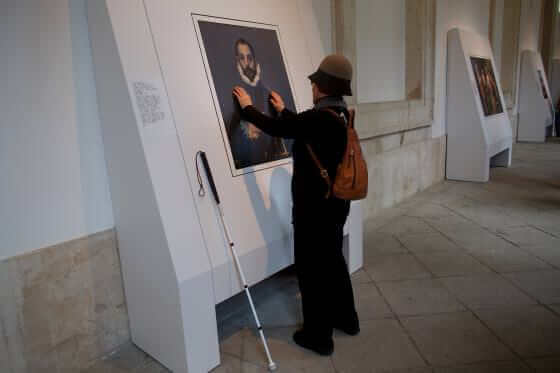By converting 2D images into 3D objects, visiting a gallery and touching the art is not only allowed — it’s positively encouraged.
Earlier this year, the Museo del Prado in Madrid launched a groundbreaking exhibit. Although many museums are taking big risks with their curating — there are museums of food and drink that serve food, and museums of perfume where one can smell — usually touching the art is strictly forbidden.
With this exhibit, global attention turns towards providing access to images for the blind and visually impaired.
“Touching the Prado” featured six paintings from the Prado collection that work both as 2D images and as tactile, 3D sculptural representations of their subject. This has made it possible for blind and visually impaired people to experience and enjoy these images — most for the first time since losing their vision, some for the first time ever. Expanding audio guides and braille text complete the experience.

The technology behind the Prado exhibit isn’t exactly 3D printed — the education team that developed the exhibit wanted to capture the original colors of the painting, to enhance the final version for visitors with the ability to see some colors and forms.
“For people with partial vision, this exhibit is perfect, because what you can’t see, you feel,” says Ana Rosa Argente, who has partial vision and is not yet blind, in conversation with NPR. “I can see light and some colors, but the rest, I use the texture to complete the picture in my mind.”
And so the Prado collaborated with a group called Estudios Dureros, which developed Didu, a paint that puffs and sets when activated by blacklight, creating both texture and volume. The exhibit curator explains that printing with this process is like “adding baking powder to a cake.”
DIY Mona Lisas, and More
Other companies have entered this space, developing other additive manufacturing techniques for creating tacticle versions of images for the blind.
The Unseen Art project aims to “create equal access for art globally” — and is using 3D printing to do so. They are currently modelling the Mona Lisa at a series of depths, and once finishing testing groups to determine which is the most “visible,” Unseen Art will make the plans available freely, so that they can be downloaded and printed by anyone with access to a 3D printer.
Whether or not the Unseen Art project is capable of handling the legal ramifications of these copies, of course, remains to be seen — but the goal of using 3D printing to make art history truly public for the blind is ambitious and exciting.
The field of architecture has also latched on to the possibility of using 3D printing to make images accessible to those with visual impairments. To celebrate the 25th anniversary of the Americans with Disabilities Act (ADA), the Miami Center for Art and Design teamed up with Florida International University to launch a project called “Listen to this Building,” which aims to think about architecture and accessibility from new angles.
This project features 3D printed models of ten iconic Miami buildings, which are placed within a box with strategically located hand-holes. Through these 3D printed models, relief sculptures, and audio storytelling, both sighted and visually impaired visitors can experience Miami’s built landscape in a totally new way.
Tearjerker Alert
All of which goes to show — while it’s clearly important to create access to visual information for the visually impaired, the impact of these project stretches way beyond only those who cannot see.
“Listen to this Building” and “Touching the Prado” bring in many visitors who aren’t blind — those with visually impaired family members, activists, or the simply curious. By simulating the experience of blindness — providing dark glasses, in the case of the Prado, or obscuring the visual model in the case of MCAD — these projects can create empathy and shared language between sighted and blind people.
One of the most exciting applications of this technology is not only for works of art in museums, but in providing the blind access to photographs. Assuming you are reading this, take a moment to imagine a life without photographs — not only famous images from museums, but photographs of your friends and family.
At the Seoul National School for the Blind, a design firm used 3D printing to create a yearbook for these students, a set of busts of their fellow classmates. We dare you to watch the design firm’s clip without tearing up; it’s clear that making 2D images 3D has a huge impact for those who have low or no vision.
In our deeply visual culture, bringing 3D representations of 2D images to museums and beyond is, perhaps, the next step.
3D Photoworks is running a campaign on Kickstarter at the moment, with the aim to provide tactile representations of 2D images both in museums and in people’s homes. As they state:
Since the invention of Braille nearly 200 years ago, advocates have worked continuously to improve access to the printed word for the blind. Today, technology makes access nearly immediate. However, a new challenge exists. The next frontier is to provide the blind with access to photographs and art, not words that describe them, but access to the actual images.
Stories about 3D printing’s ability to make 2D images “visible” in 3D are incredibly touching. It’s easy to see why makers working in this field say they won’t stop until 3D images are in every museum in the world.
As seventh-grader Luc Gandarias says of 3D Photoworks’ Mona Lisa, ”When I felt her mouth, I could even tell that the Mona Lisa has a secret. She’s not letting us onto it. I know that I’m blind, but even I could tell that.”
License: The text of "Creating Tactile Artwork for the Blind and Visually Impaired" by All3DP is licensed under a Creative Commons Attribution 4.0 International License.
